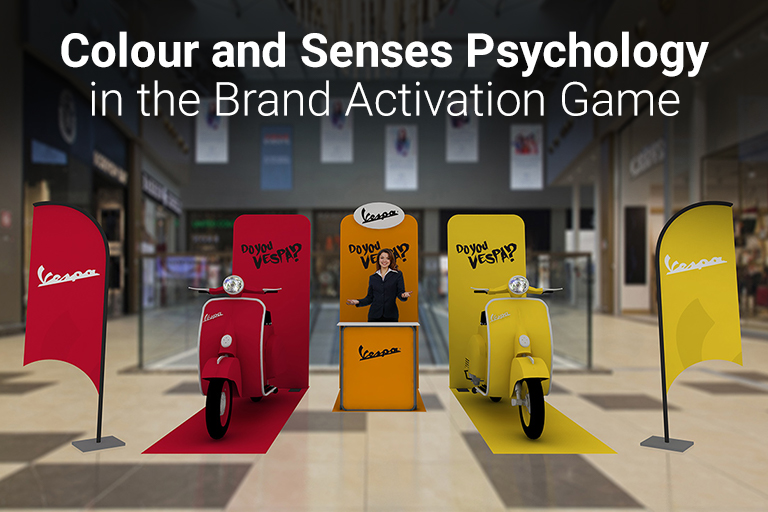Colour and Senses Psychology in the Brand Activation Game
In India’s bustling, diverse markets, where consumers are flooded with various brands daily, standing out requires more than just traditional marketing tactics. With the emerging realm of sensory branding, a strategy that engages more than just visual senses, businesses can create memorable brand experiences. This approach uses colour psychology in branding and other sensory cues to influence consumer behaviour and create deeper emotional connections with the brand. By combining sensory elements thoughtfully, brands can go beyond the limits of conventional advertising. This turns ordinary interactions into rich, memorable experiences that resonate with the audience on many levels.
The concept of branding and psychology isn’t new, but the application of comprehensive sensory branding is gaining momentum, especially in culturally rich landscapes of India. Colours, sounds, textures, and even scents play important roles in this strategy, each adding a layer of depth and meaning to the brand’s narrative. Sensory branding doesn’t just capture attention; it immerses consumers in a curated brand universe, enhancing engagement and loyalty. Brands that use sensory marketing effectively can tap into the consumer’s subconscious, influencing not only their current conception but also their long-term memory of the brand.
Here’s how you can harness the power of colour and senses to nail the brand activation game:
Role of Colour in Branding
Colour psychology in branding is a powerful tool, especially in a country as colourful as India, where each hue holds significant cultural and emotional weight. Each colour can trigger specific emotions and actions from consumers based on societal, cultural, and personal experiences. Hence, colour choice is a critical consideration in branding strategies. Some of the colours that can induce strong responses are:
- Red
Often associated with passion, excitement, and vitality, red is a powerful colour in the Indian context, symbolising prosperity and festivities. Brands often use red in their logos, sale banners, and festive campaigns to draw attention and stimulate purchase behaviours. - Green
This colour denotes nature, health, and tranquillity, aligning well with organic and eco-friendly brands. In India, green also has strong cultural associations with growth and harmony, making it effective for brands that want to emphasise sustainability and natural ingredients. - Blue
A symbol of stability, trust, and serenity, blue is extensively used by banks, insurance companies, and technology firms. It is preferred for its calming effect on consumers, which helps in building a perception of reliability and trustworthiness. - Yellow
Reflecting energy, happiness, and youth, yellow is an attention-grabbing choice for brands targeting the younger generation or promoting leisure and entertainment-focused products. - White and Black
Often used to convey simplicity and sophistication respectively, these colours can be crucial in luxury brand activations. White creates a sense of purity and space, while black brings an element of luxury and exclusivity.
Role of Senses in Branding
Sensory branding involves making use of all senses to create a holistic brand experience that can significantly enhance consumer engagement and loyalty. This is how brands can engage multiple senses:
- Sight
Sight is the most powerful among all the senses. A well-crafted logo with an effective colour combination can make a brand instantly recognisable. To truly captivate consumers, businesses must think creatively about their visual presentation. To attract and maintain customer attention, it’s essential to offer new perspectives on the brand’s products. - Touch
The texture and feel of products are essential, especially in a market like India where shopping is a tactile experience. For example, the smooth finish of a smartphone or the rough texture of organic clothing can influence consumer perceptions of quality and value. - Sound
The sounds associated with a brand, from the music played in stores to the voice in advertisements, help in creating an ambience and emotional tone. Traditional or contemporary Indian music, for instance, can be used to resonate with specific audiences, invoking nostalgia or a sense of modernity. - Smell
Scents are powerful emotional triggers. Retail environments can enhance their appeal with distinct fragrances. For instance, a bookstore might use a coffee scent to create a relaxed atmosphere, encouraging its customers to relax. - Taste
For food and beverage brands, taste is obviously important. Sample tastings and flavour-rich experiences can be strong tools in such activations, providing direct engagement with the product.
Integration of Colours and Senses into Brand Strategies
For a successful brand activation in India, it is crucial to incorporate sensory elements thoughtfully to ensure that they are in line with the brand’s identity and campaign objectives. Here are some of the strategies to consider:
- Cultural Relevance
Brands can choose colours and sensory elements that resonate with local preferences and cultural contexts. For example, saffron and green may have significant meanings in the Indian context, tied to national identity and religious sentiments. - Demographic Targeting
For brands, understanding the demographics of their target audience is important. Young consumers might be drawn to vibrant and energetic colours, whereas older ones may prefer light shades and sophisticated sensory experiences. - Consistency Across Touchpoints
Brands must ensure that colours and sensory elements are consistent across all touchpoints to create a balanced experience. This consistency helps reinforce brand identity and improve recall. - Testing and Feedback
Before full-scale implementation, testing of sensory elements in sample activations is necessary to gather feedback and make adjustments accordingly. This can help in understanding what resonates best with the Indian audience.
Conclusion:
In the dynamic and diverse Indian market, brands that successfully integrate sensory branding strategies set themselves apart. By introducing colour psychology in branding, combined with a good application of other sensory elements, brands can create deep and lasting impressions. This method does more than just sell a product; it builds a narrative that consumers feel a part of. Sensory branding taps into the cultural richness of India, transforming standard marketing into a more immersive, emotionally resonant practice. Brands that master this art capture market share and win hearts, making sensory branding not just a marketing strategy but a crucial part of building a lasting legacy in the Indian marketplace.
About Insta Brand Activation
Insta Brand Activation(IBA) is at the forefront when it comes to creating memorable brand experiences for engagement and growth. Our innovative portable displays bring your brand to life in the public eye. The Active Box, our corporate activation kit, serves as a perfect platform to deliver your message directly to your target audience, wherever they may be. Through creative, impactful setups, IBA crafts tangible connections between your brand and the public. Quit the waiting game and partner with IBA to enhance your brand awareness with our portable and reusable brand activation setups.




